“In a country where every gentleman is a soldier, and every soldier a student in the art of war, it necessarily follows that military treatises will be considerably sought after, and attended to.”
– Hugh Henry Ferguson, editor of the American edition of Military Instructions for Officers Detached in the Field (Philadelphia, 1775)
The young officers of the Continental Army who pledged their lives to the cause of American independence were enthusiastic and ambitious, but most entered service without military experience or training. Even the senior commanders were self-taught warriors, relying on knowledge learned from books to expand on lessons learned in the field. George Washington, Henry Knox and other leaders urged their men to study the growing literature on the art of war to prepare for the role of leading troops in battle against the British army.
To meet the demand for military texts, a flood of printings began to appear from the American presses. Much of this activity was centered in Philadelphia, where more than thirty works on military subjects were published in the years 1775 and 1776 alone. Initially these books were reprints or new editions of British or European standards, but publishers quickly turned to a new generation of American military authors whose works reflected the immediacy of the war.
In 1779, Congress ordered the publication of the first official manual for the Continental Army, Regulations for the Order and Discipline of the Troops of the United States. Written by Gen. Friedrich Wilhelm Steuben, the Prussian volunteer who had transformed the army at Valley Forge, the Regulations codified the governance of the army, from the basic drill to the specific duties of each officer rank. Finally Washington’s army was reading from the same book, a crucial step in building the fighting force that would win American independence.
Books in the Field featured thirty-one books that were read and studied by American soldiers and citizens during the Revolutionary War. Also on exhibit were manuscripts and other items that tie the books to actual use in the period. A highlight of the show was an original Continental Army knapsack of the type that might have carried its owner’s military books, on loan from a private collection.
The books in the exhibition were drawn from the Robert Charles Lawrence Fergusson Collection on the art of war, which marked its thirtieth anniversary in 2018.
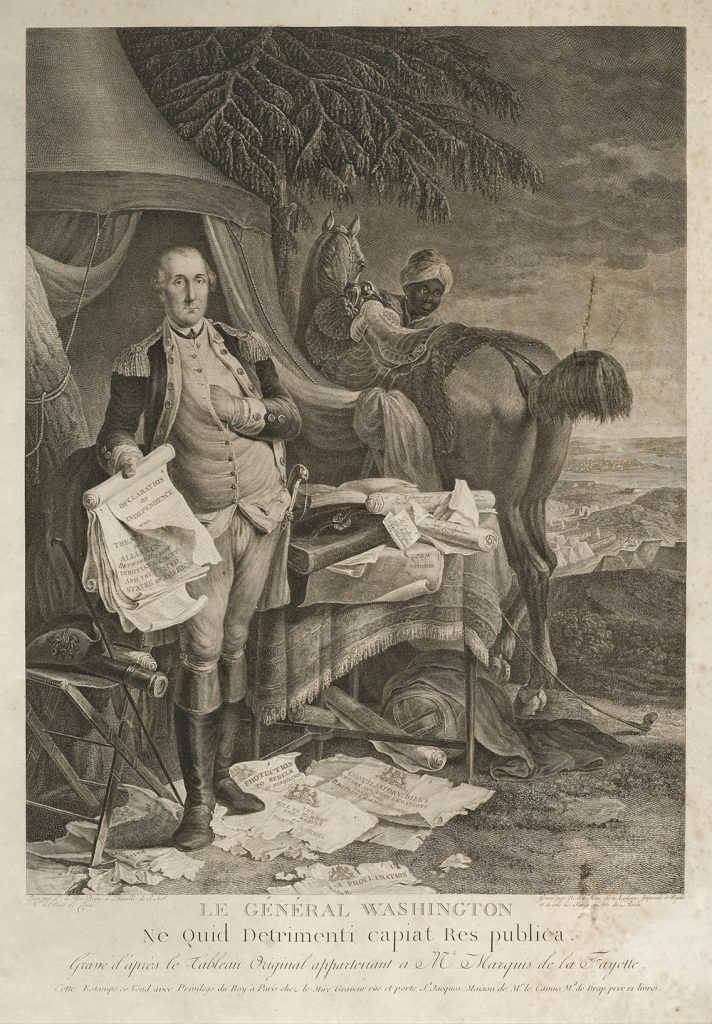
Le General Washington
Noël Le Mire, engraver; after Jean-Baptiste Le Paon, artist
Paris: Chez Le Mire, 1780The Society of the Cincinnati, Gift of Trafford Partridge Klots, 1964
The importance of books and reading to early American military training is modeled in the career of George Washington. Leading by example, he urged his officers to read and study to learn the art of war.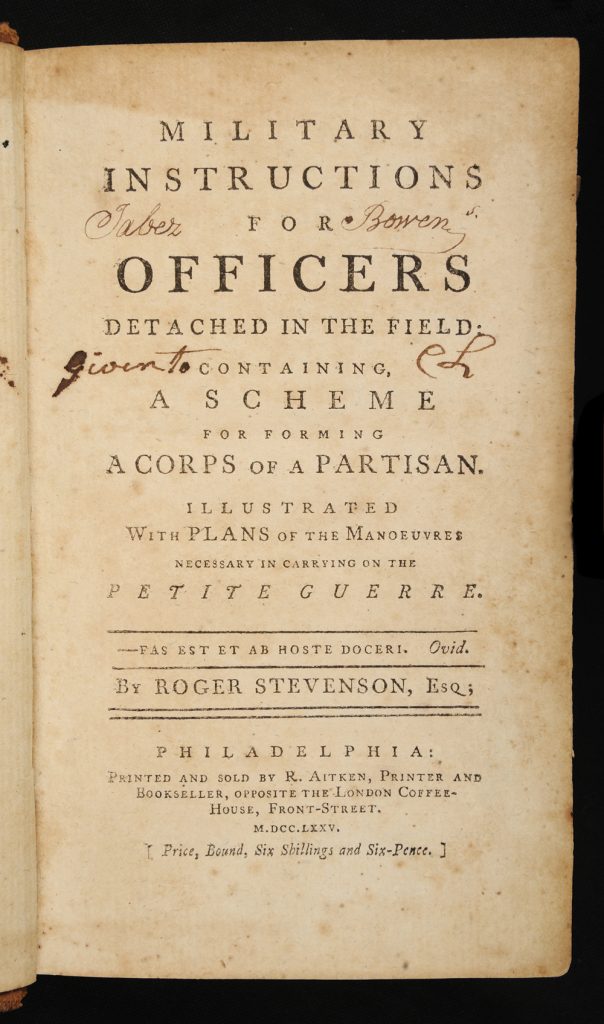
Military Instructions for Officers Detached in the Field
Roger Stevenson
Philadelphia: Printed and sold by R. Aitken, 1775The Society of the Cincinnati, The Robert Charles Lawrence Fergusson Collection
The American edition of this British standard was a bestseller for Philadelphia printer Robert Aitken. This is the first book to be dedicated to George Washington.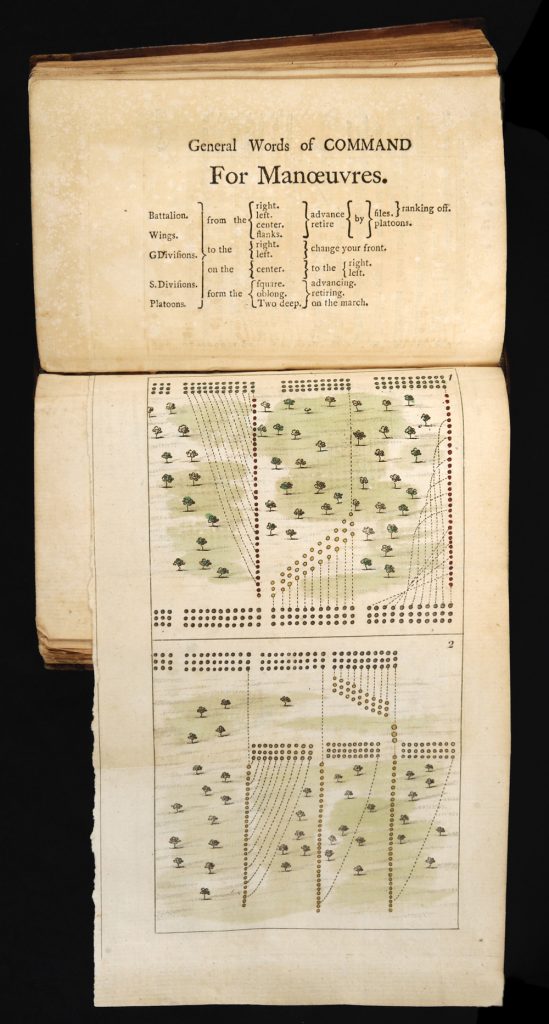
Manoeuvres, or, Practical Observations on the Art of War
William Young, compiler
London: Printed for J. Millan, [1771?]The Society of the Cincinnati, The Robert Charles Lawrence Fergusson Collection
This compilation of several treatises on exercise, fortification and maneuvers also includes a printing of General Wolfe’s Instructions to Young Officers. George Washington owned a copy and recommended this work to his officers.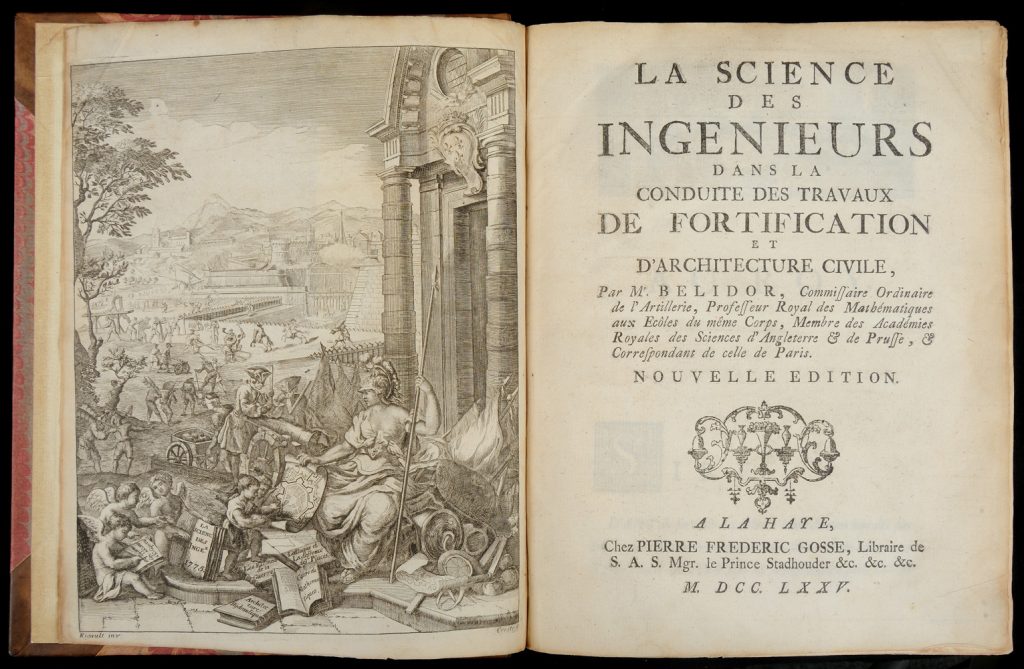
La Science des Ingénieurs
Bernard Forest de Belidor
La Haye: Chez Pierre Frederic Grosse, 1775The Society of the Cincinnati, The Robert Charles Lawrence Fergusson Collection
In a letter to John Adams about the best books on military art and science, Judge Advocate William Tudor wrote that “Bellidore (which General Gates tells me is worth all the rest) is not own’d by any Gentlemen in the army.”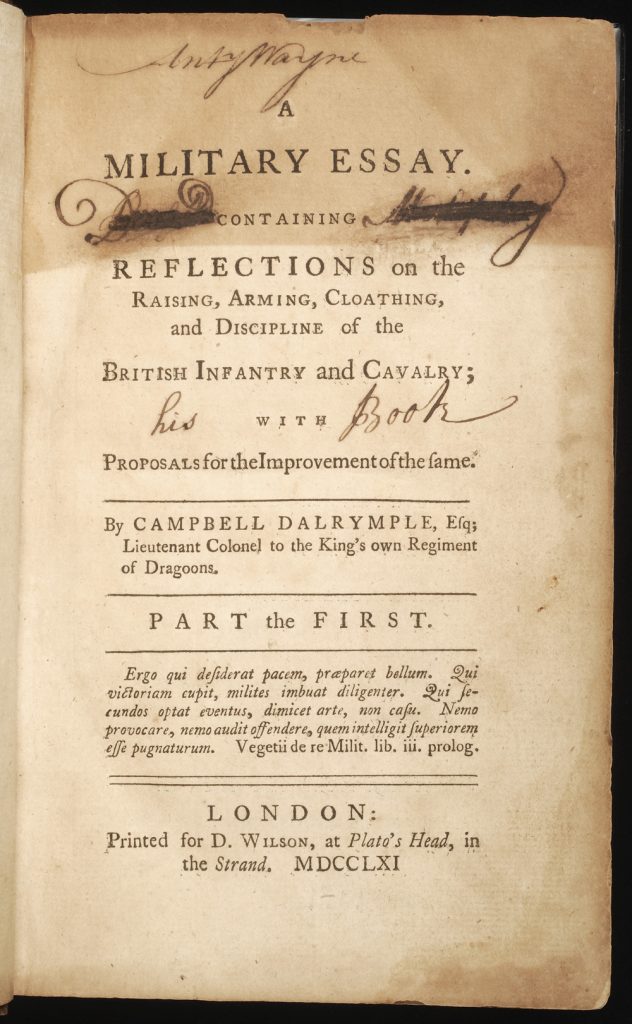
A Military Essay Containing Reflections on the Raising, Arming, Cloathing, and Discipline of the British Infantry and Cavalry
Campbell Dalrymple
London: Printed for D. Wilson, 1761The Society of the Cincinnati, The Robert Charles Lawrence Fergusson Collection
Dalrymple’s Military Essay appeared on John Adams’s master list of military books that should be in circulation in the army. This copy belonged to Brig. Gen. Anthony Wayne, who inscribed his name on the title page.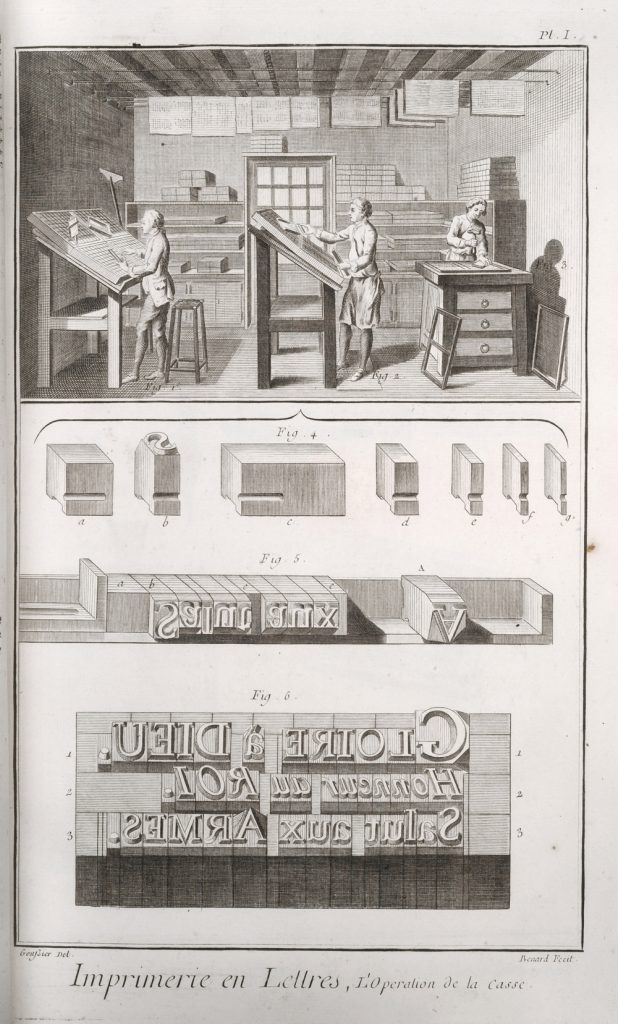
Imprimerie en Lettres, L’Operation de la Casse
In Encyclopédie, ou Dictionnaire Raisonné des Sciences des Arts et des Métiers edited by Denis Diderot and Jean Le Rond d’Alembert
Paris: Chez Braisson and Le Breton, 1769The Society of the Cincinnati, The Robert Charles Lawrence Fergusson Collection
Although the output of American printers often lacked the refinement of that of their European counterparts, the basic operations of making books in the eighteenth century were universal. Shown here is the meticulous process of setting lead type in wooden trays to create forms for a printed page. This plate appears in a volume from Diderot’s Encyclopédie that includes a series of illustrations of the many aspects of the printer’s trade.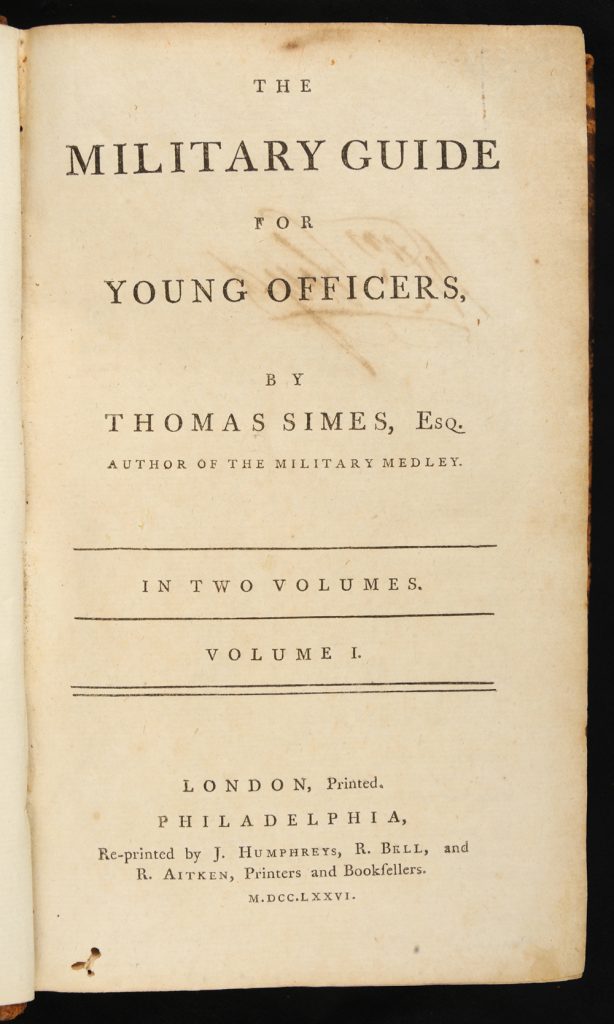
The Military Guide for Young Officers
Thomas Simes
London, Printed; Philadelphia: Re-printed by J. Humphreys, R. Bell, and R. Aitken, 1776The Society of the Cincinnati, The Robert Charles Lawrence Fergusson Collection
Simes’s guide was a synthesis of the works of several military authors, including Humphrey Bland and the comte de Saxe. This copy bears the ownership signature of William Floyd, a signer of the Declaration of Independence.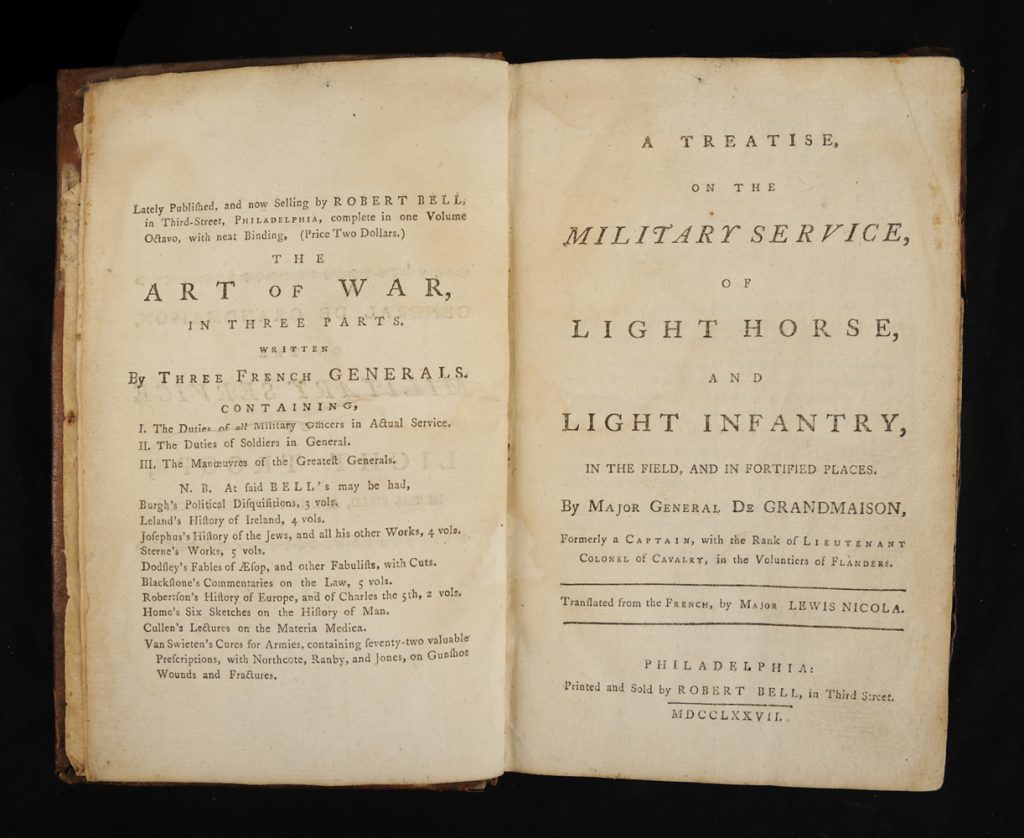
A Treatise on the Military Service of Light Horse and Light Infantry
Thomas Auguste le Roy de Grandmaison; Lewis Nicola, translator
Philadelphia: Printed and sold by Robert Bell, 1777The Society of the Cincinnati, The Robert Charles Lawrence Fergusson Collection
George Washington owned a copy of this English translation of an influential work by a Flemish cavalry officer. Opposite the title page is the publisher’s advertisement for another new work on the art of war.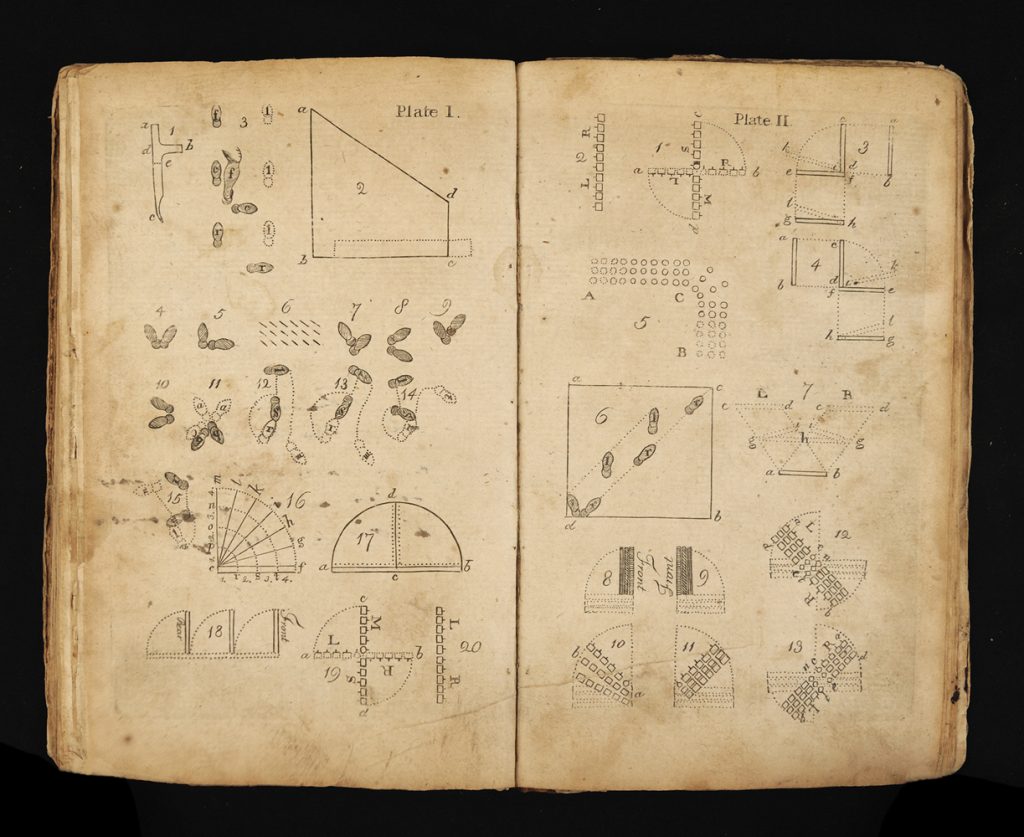
An Easy Plan of Discipline for a Militia
Timothy Pickering
Boston: Printed and sold by S. Hall, 1776The Society of the Cincinnati, The Robert Charles Lawrence Fergusson Collection
Pickering’s Plan was praised for not being “clogged with many superfluous motions which only serve to burden the memory and perplex the learner.” This plate from it suggests that his manual exercise was complex enough.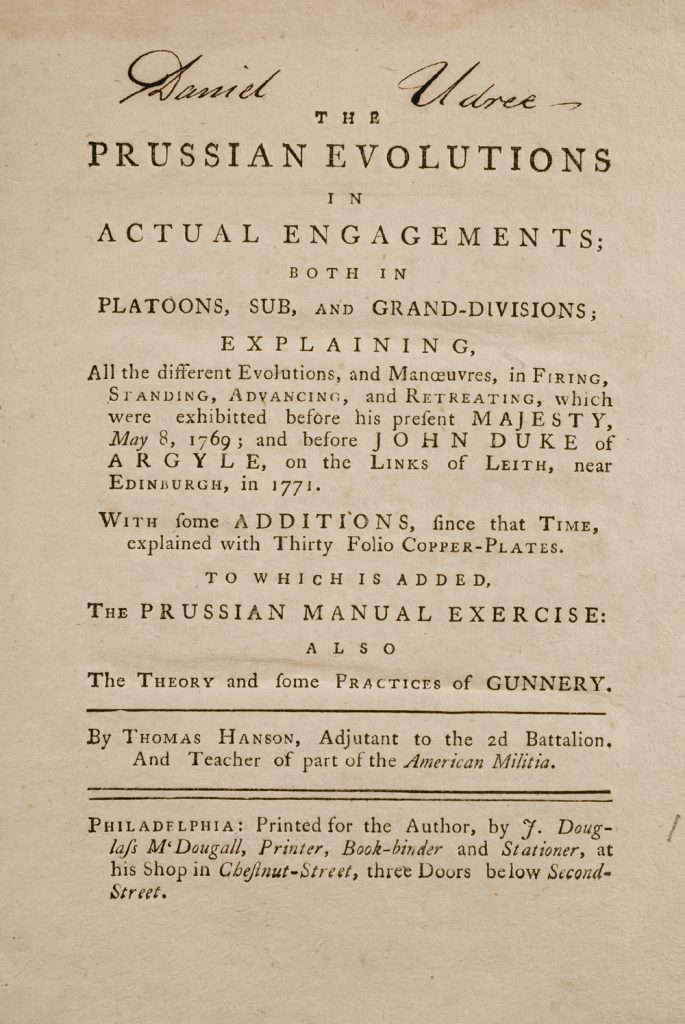
The Prussian Evolutions in Actual Engagements
Thomas Hanson
Philadelphia: Printed for the author, by J. Douglass McDougall, 1775The Society of the Cincinnati, The Robert Charles Lawrence Fergusson Collection
Thomas Hanson, an adjutant of the Philadelphia Associators, adapted the manual exercise of Frederick the Great’s army for the use of the Americans. George Washington appears on the book’s five-page subscribers’ list, with an order for eight copies noted beside his name.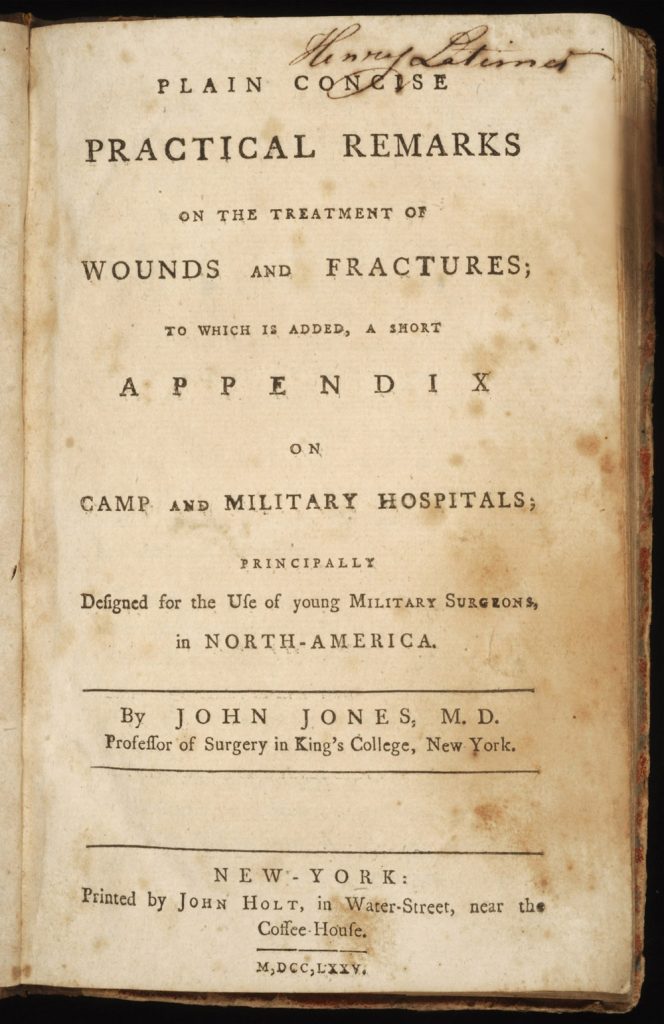
Plain Concise Practical Remarks on the Treatment of Wounds and Fractures
John Jones
New-York: Printed by John Holt, 1775The Society of the Cincinnati, The Robert Charles Lawrence Fergusson Collection
This copy of Dr. Jones’s treatise “designed for the Use of young Military Surgeons in North-America” belonged to Henry Latimer of Delaware, who directed the army’s “Flying Hospital,” a mobile surgical unit.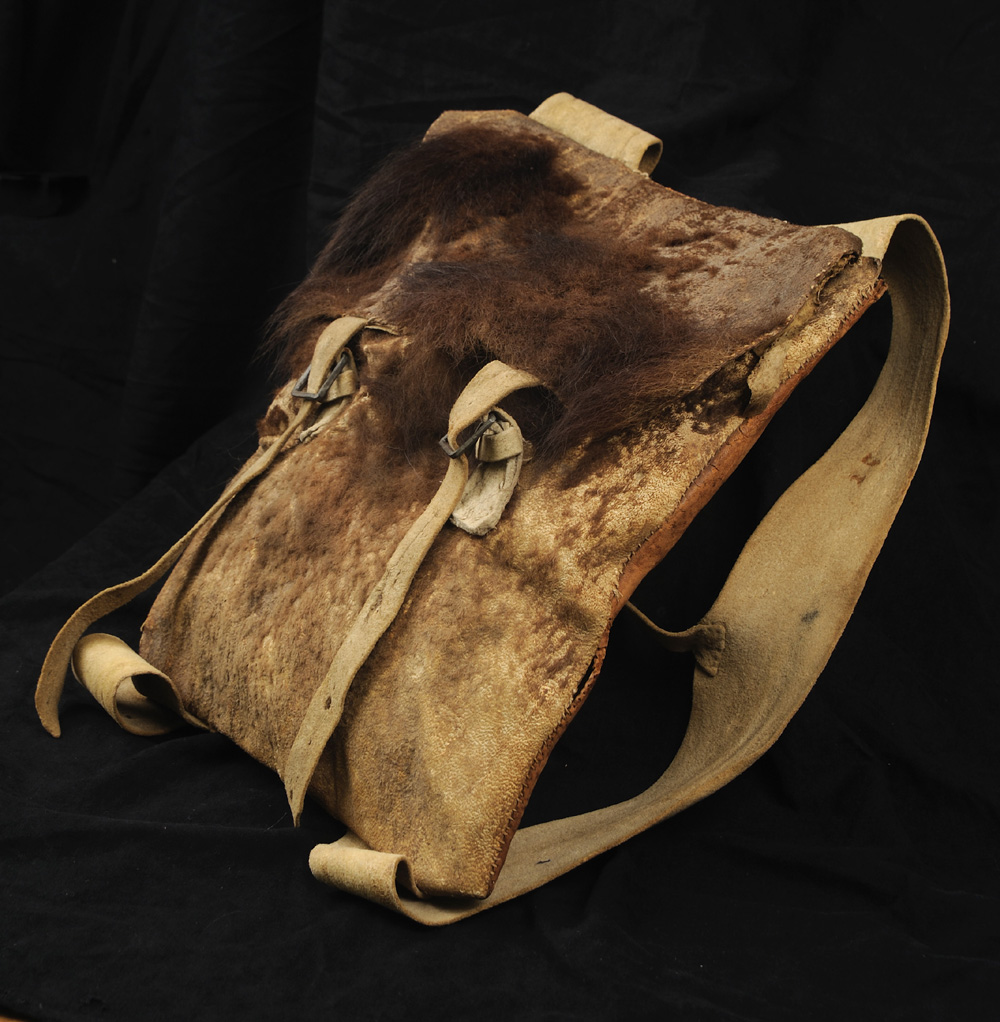
Knapsack
American
ca. 1777Private Collection
Johann von Ewald, a Hessian officer in British service, made note of Americans’ study of the art of war: “I was sometimes astonished when American baggage fell into our hands during that war to see how every wretched knapsack, in which were only a few shirts and a pair of torn breeches, would be filled up with military books.” This knapsack, made of black bear skin and leather, was owned by Sgt. Elisha Gross of the Third Continental Artillery.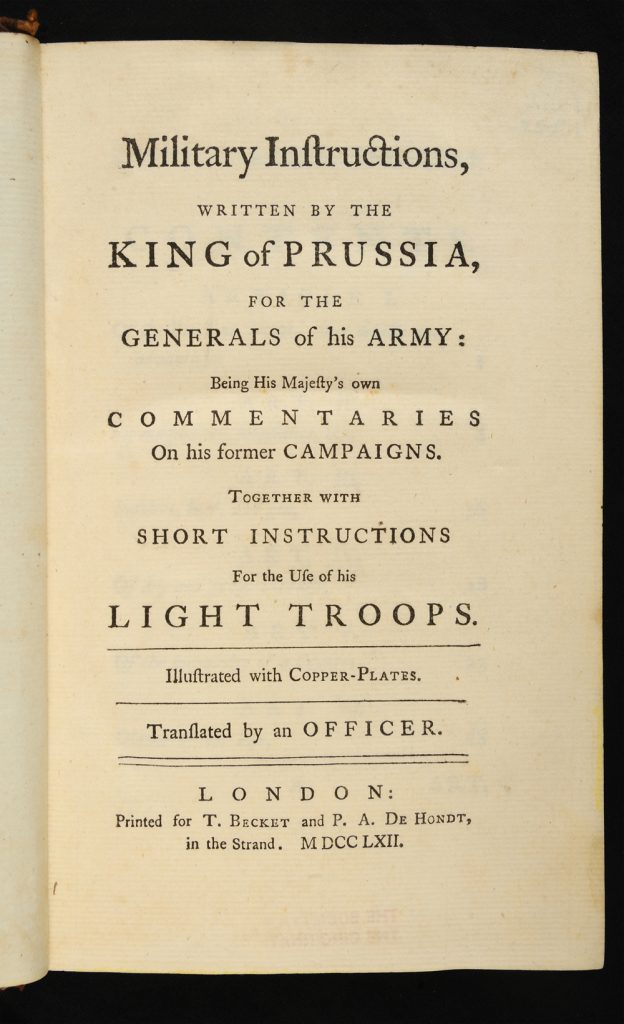
Military Instructions, Written by the King of Prussia, for the Generals of His Army
London: Printed for T. Becket and P.A. De Hondt, 1762The Society of the Cincinnati, The Robert Charles Lawrence Fergusson Collection
Captain Ewald listed “Instructions of the King of Prussia to his Generals” among the works that “came into my hands a hundred times” from captured American soldiers.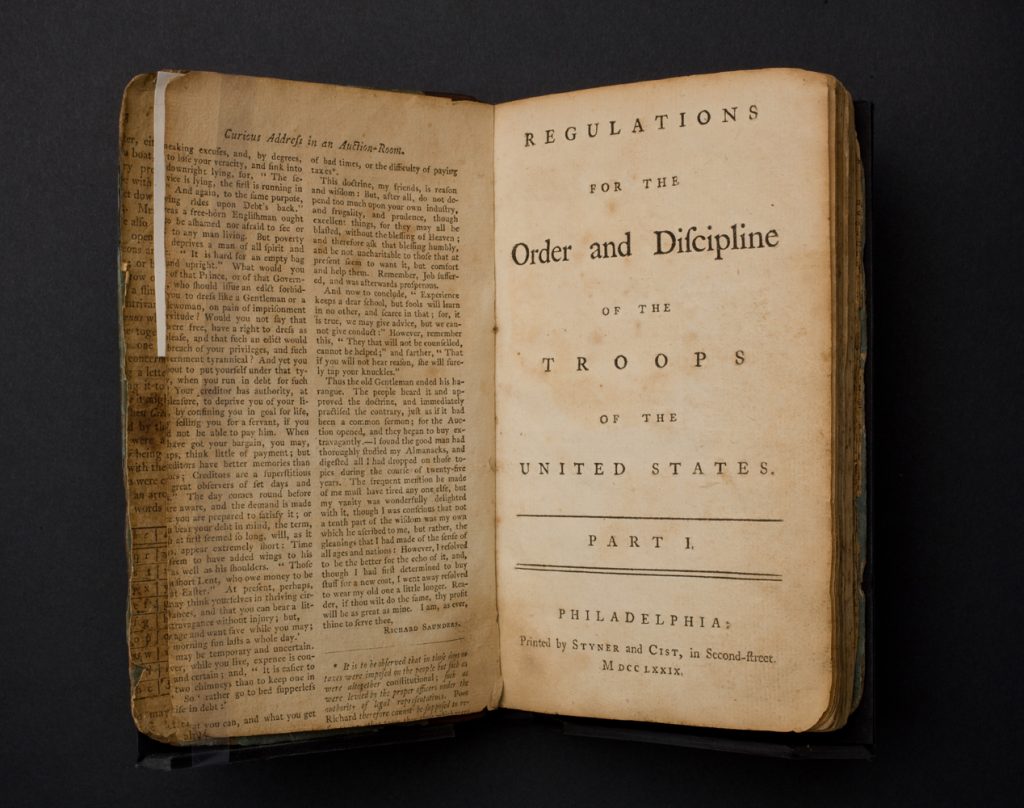
Regulations for the Order and Discipline of the Troops of the United States
Friedrich Wilhelm Ludolf Gerhard Augustin Steuben
Philadelphia: Printed by Styner and Cist, 1779The Robert Charles Lawrence Fergusson Collection
The first official manual of the American army was published in 1779 on the order of Congress, which directed that the Regulations “be observed by all the troops of the United States, and that all general and other officers cause the same to be executed with all possible exactness.”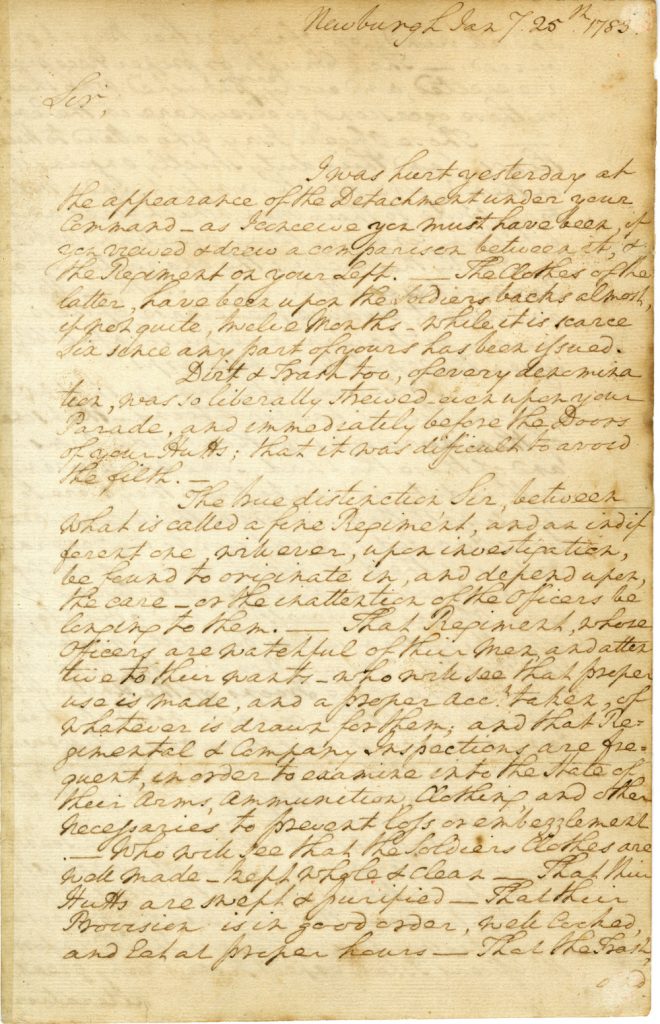
George Washington to Thomas Lancaster Lansdale
January 25, 1783The Society of the Cincinnati, Gift of Evelyn Lansdale Wildman and Clare Lansdale Johnston, 1977
In this letter, Washington severely chastised the commander of a Maryland unit for the appearance of his men and conditions of his camp, writing, “[I] recommend in pointed terms to your Officers the necessity, and advantage of making themselves perfectly masters of the Printed ‘Regulations for the Order & Discipline of the Troops of the United States’ Ignorance of them cannot, nor will it be, any excuse.”